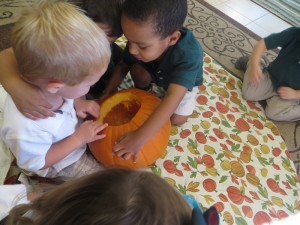Why Montessori Education?
 The Montessori approach embraces the full development of the child and addresses all aspects (physical, social, emotional, cognitive and spiritual) of the whole child. Children are grouped in mixed ages and abilities within 3 developmental years. There is constant interaction, problem solving, child to child teaching, and socialization. Children are challenged according to their ability and never bored.
The Montessori approach embraces the full development of the child and addresses all aspects (physical, social, emotional, cognitive and spiritual) of the whole child. Children are grouped in mixed ages and abilities within 3 developmental years. There is constant interaction, problem solving, child to child teaching, and socialization. Children are challenged according to their ability and never bored.
A Brief History
Montessori education was founded in 1907 by Dr. Maria Montessori. She based her educational methods on scientific observation of children’s learning processes. Dr. Montessori discovered that children teach themselves through observation and exploration. Based on this discovery, she designed a “prepared environment” in which children could freely choose from a number of developmentally appropriate activities.
Montessori Versus Traditional Education
| Montessori Education | Traditional Education |
|---|---|
| Emphasis on cognitive structures and social development | Emphasis on rote knowledge and social development |
| Teacher’s role is unobtrusive; child actively participates in learning | Teacher’s role is dominant, active; child is a passive participant |
| Environment and method encourage internal self-discipline | Teacher is primary enforcer of external discipline |
| Individual and group instruction adapts to each student’s learning style | Individual and group instruction conforms to the adult’s teaching style |
| Mixed-age grouping | Same-age grouping |
| Children encouraged to teach, collaborate, and help each other | Most teaching done by teacher and collaboration is discouraged |
| Child formulates concepts from self-teaching materials | Child is guided to concepts by teacher |
| Child works as long as he/she wants on a chosen project | Child usually is given specific time for work |
| Child sets own pace to internalize information | Instruction pace set by group norm or teacher |
| Child spots own errors through feedback from material | Errors corrected by teacher |
| Learning is reinforced internally through child’s own repetition of activity, internal feelings of success | Learning is reinforced externally by rewards, discouragement |
| Multi-sensory materials for physical exploration development | Few materials for sensory, concrete manipulation |
| Organized program for learning care of self and self-care environment (shoe polishing, sink washing, etc.) | Little emphasis on instruction or classroom maintenance |
| Child can work where he/she is comfortable, move and talk at will (yet doesn’t disturb others); group work is voluntary and negotiable | Child assigned seat; encouraged to sit still and listen during group sessions |
| Organized program for parents to understand the Montessori philosophy and participate in the learning process | Voluntary parent involvement, often only as fundraisers, not participants in understanding the learning process |

